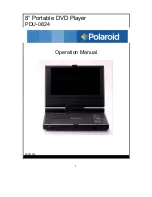
68-00183 Rev. C
Quantum Data, Inc.
Page 5
Special Operating Modes
Probe Sync Pulse Output
The FS connector on the sync module can output a TTL Level probe
pulse that can be used to trigger an oscilloscope or to synchronize a
camera used in automated vision systems. The pulse can be
positioned manually by the operator or by commands sent by a test
system. The horizontal timing can be set to a given pixel clock cycle relative to either the horizontal
sync pulse or the start of active video for a given line. The vertical timing is set to a given scan line
relative to either the vertical sync pulse or the start of active video in the frame. A marker can be added
to the video outputs when the pulse occurs during the active portion of the video test signal.
Example of Using the Probe Pulse Feature
Let’s say the image displayed on the monitor looks bad at (900; 200); i.e. it is bad on active line # 200 at
active pixel # 900 on that line. You can set the probe pulse to trigger an oscilloscope to look at the video
signal for that position as it passes through the monitor’s circuits.
Manually Operation of Probe Pulse Feature
1 ) Turn the test signal outputs off using the “Outputs” button (if not already off).
2 ) While holding down the “Image/Step” Button, press the “Outputs” button to turn the outputs on.
3) The generator will output the same video format and test image that
were last selected. The LCD window will change to the Probe Pulse
User Interface shown here. The video and sync gating buttons get new
functions in this operating mode. You can not use the buttons to gate
colors or change sync gating when the probe pulse feature is active.
The number after “P:” is the position of the probe on a given scan line relative to the leading edge of
horizontal sync measured in pixel clock cycles. The number after “L:” is the number of the scan line
relative to the leading edge of vertical blanking. For interlaced formats the line number is relative to the
start of blanking for the first field. If the horizontal probe position is within the active area of the screen,
then the X coordinate of the pixel (X:nnnn) is also displayed. Likewise, if the vertical position of the
probe is in the active area, then the Y coordinate of the line (Y:nnnn) is also displayed. For interlaced
formats, the L count will move the probe in consecutive lines in one field of video and then move on
through blanking and the next field of video. This will cause the Y count to increment in steps of two.
The Format knob adjusts the “P:nnnn” horizontal timing probe position, while the Image knob adjusts
the “L:nnnn” vertical timing probe position. The knobs have an exponential taper which is reset
whenever the knob reverses direction. This feature provides boath coarse and fine adjustments (i.e. you
do not have to rotate the knob a thousand times to get to where you are going.). You can also use the
sync gating buttons lock which digits are changed by the knobs. Pressing the “ACS” button will cause
the knobs to step the counts in 100 unit increments. Pressing the “DCS” button will cause the knobs to
step the counts in 10 unit increments. Pressing the “DSS” button will cause the knobs to step the
counts in 1 unit increments. Pressing the same button a second time will revert the knobs to exponential
operation.
P:nnnn X:nnnn
L:nnnn Y:nnnn






























